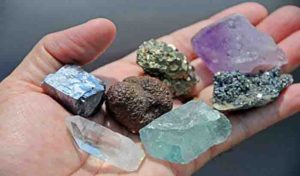
What is Mineral?
A mineral is a naturally occurring chemical compound, usually of crystalline form and abiogenic in origin (not produced by life processes). A mineral has one specific chemical composition, whereas a rock can be an aggregate of different minerals or mineraloids. The study of minerals is called mineralogy.
There are over 5,300 known mineral species; as of March 2017, over 5,230 of these had been approved by the International Mineralogical Association (IMA). The silicate minerals compose over 90% of the Earth’s crust. Silicon and oxygen constitute approximately 75% of the Earth’s crust, which translates directly into the predominance of silicate minerals.
Minerals are distinguished by various chemical and physical properties. Differences in chemical composition and crystal structure distinguish the various species, which were determined by the mineral’s geological environment when formed. Changes in the temperature, pressure, or bulk composition of a rock mass cause changes in its minerals.
Minerals can be described by their various physical properties, which are related to their chemical structure and composition. Common distinguishing characteristics include crystal structure and habit, hardness, lustre, diaphaneity, colour, streak, tenacity, cleavage, fracture, parting, specific gravity, magnetism, taste or smell, radioactivity, and reaction to acid. (How to Identify Minerals?)
Minerals are classified by key chemical constituents; the two dominant systems are the Dana classification and the Strunz classification. The silicate class of minerals is subdivided into six subclasses by the degree of polymerization in the chemical structure. All silicate minerals have a base unit of a [SiO4]4− silica tetrahedron—that is, a silicon cation coordinated by four oxygen anions, which gives the shape of a tetrahedron. These tetrahedra can be polymerized to give the subclasses: orthosilicates (no polymerization, thus single tetrahedra), disilicates (two tetrahedra bonded together), cyclosilicates (rings of tetrahedra), inosilicates (chains of tetrahedra), phyllosilicates (sheets of tetrahedra), and tectosilicates (three-dimensional network of tetrahedra). Other important mineral groups include the native elements, sulfides, oxides, halides, carbonates, sulfates, and phosphates.
What is Mineraloid?
A mineraloid is a mineral-like substance that does not demonstrate crystallinity. Mineraloids possess chemical compositions that vary beyond the generally accepted ranges for specific minerals. For example, obsidian is an amorphous glass and not a crystal. Jet is derived from decaying wood under extreme pressure. Opal is another mineraloid because of its non-crystalline nature. Pearl, considered by some to be a mineral because of the presence of calcium carbonate crystals within its structure, would be better considered a mineraloid because the crystals are bonded by an organic material, and there is no definite proportion of the components.
Examples:
- Amber, non-crystalline structure, organic
- Chlorophaeite
- Deweylite, a mixture of serpentine and talc or stevensite
- Ebonite, vulcanized natural or synthetic rubber (organic); lacks a crystalline structure
- Jet, non-crystalline nature, organic (very compact coal)
- Lechatelierite, nearly pure silica glass
- Limonite, a mixture of oxides and hydroxides of iron
- Mercury, liquid (IMA/CNMNC valid mineral name)
- Obsidian, volcanic glass – non-crystalline structure, a silica rich glass
- Opal, non-crystalline hydrated silica silicon dioxide (IMA/CNMNC valid mineral name)
- Palagonit
- Pearl, organically produced carbonate
- Petroleum, liquid, organic
- Pyrobitumen, amorphous fossilized petroleum (noncrystalline, organic)
- Sideromelane
- Shungite, black, lustrous, more than 98 weight percent of carbon
- Tektites, meteoritic silica rich glass
Reference:
Wikipedia: Mineral
Wikipedia: Mineraloid










